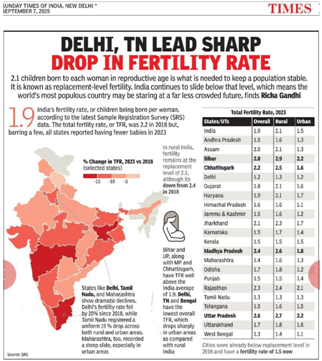

8th September 2025 (12 Topics)
Context:
The Sample Registration System (SRS) Statistical Report 2023 shows India’s Total Fertility Rate (TFR) has declined to 1.9 in 2023 from 2.0 in 2022, with rural TFR reaching the replacement level of 2.1 for the first time.
Total Fertility Rate (TFR)
- TFR measures the average number of children born to a woman during her reproductive span (15–49 years).
- India reached the replacement level fertility of 1 in 2019, and since 2020, TFR has remained at or below 2.0.
- Rural–urban difference persists: Rural TFR at 2.1 (2023) Urban TFR at 1.5 (2023).
- Highest TFR states: Bihar (2.8), Uttar Pradesh (2.6), Madhya Pradesh (2.4).
- Lowest TFR states/UTs: Delhi (1.2), Tamil Nadu and West Bengal (1.3 each).

Gross Reproduction Rate (GRR)
- GRR is the average number of daughters a woman would give birth to during her lifetime if she experiences current age-specific fertility rates (ASFRs) and no mortality.
- India’s GRR (2023) is 0.9, with rural GRR at 1.0 and urban GRR at 0.7.
- State-wise variation: Delhi, West Bengal, Tamil Nadu (0.6) vs. Bihar (1.3).
Infant Mortality Rate (IMR)
- IMR declined from 32 (2018) to 25 (2023), showing a fall of seven points in five years.
- Rural IMR fell by 8 points (36 to 28), urban IMR fell by 5 points (23 to 18).
- Highest IMR: Chhattisgarh, Madhya Pradesh, Uttar Pradesh (37 each).
- Lowest IMR: Manipur (3) and Kerala (5).
- Despite decline, 1 in 40 infants die before completing one year of age.
More Articles


